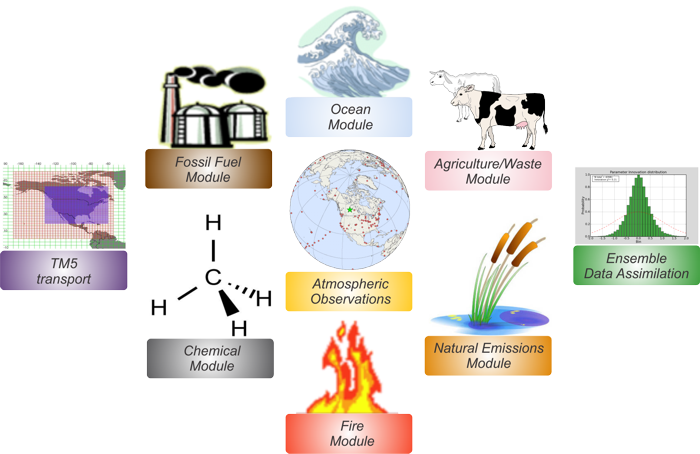Information
Home FAQ Project Goals Documentation Collaborators TutorialResults
Fluxes Observations Evaluation Visualization DownloadGet Involved
Suggestions E-mail List Contact UsResources
How to Cite Version History Glossary References Bibliography
To learn more about a CarbonTracker component, click on one of the above images.
Or download the full PDF version for convenience.
Agriculture and Waste
Introduction
The largest source of methane emitted by human activity is associated with agriculture, animals and their waste (230-250 TgCH4/yr). Ruminants, such as cattle, goats, sheep and buffalo are able to convert hard-to-digest forage to energy through a process called enteric fermentation, in which microbes produce easily digested material inside the animal's gut. Most of the methane produced in this way exits the animal via belching, however, a small portion emerges as the result of flatulence. Methane emissions from animals can be reduced by use of more easily digested feed. Emissions from enteric fermentation are expected to increase as global population grows and standards of living are improved.
Animal waste, wastewater and landfills produce methane when conditions favor anaerobic decomposition. This is the process by which organic material decomposes in low oxygen conditions through chains of microbial processes resulting in the production of mostly methane as well as some carbon dioxide. Methane produced in landfills or waste treatment facilities is now often captured and used as fuel rather than being vented to the atmosphere.
Rice agriculture is also a significant source of methane to the atmosphere. This is because warm, waterlogged rice paddies are ideal for development of anaerobic conditions and methanogenesis. Bottom-up estimates of emissions from rice agriculture are about ~50 TgCH4/yr, and emissions can be significantly reduced by drainage of paddies between harvests, application of fertilizer and development of varieties of rice that tolerate drier conditions.
Detailed Description
This release of CarbonTracker-CH4 uses the 1x1 degree gridded emissions from the EDGAR 3.2FT2000 as prior emission estimates for emissions from rice agriculture, enteric fermentation, animal waste management, wastewater and landfills. This data set is based on emission inventories by country and sector for the years 1990 and 1995 extrapolated to 2000 using production and consumption statistics. We have not extrapolated this data over the period covered by CarbonTracker, and have instead kept prior emission estimates constant at 2000 levels. This will allow us to test whether the assimilation is able to recover trends in emissions since all of these emission processes can be expected to increase with population unless steps are taken to mitigate emissions.
